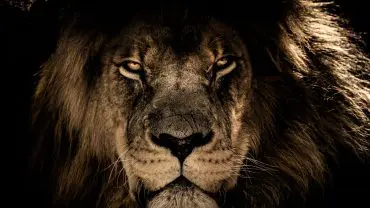Known as the Amoy tiger, Chinese tiger and Xiamen tiger, Panthera tigris amoyensis is believed to be a relict population – that is the only direct descendent from the stem, or original tiger species – from which all other subspecies are derived.
Today, the unfortunately reality is that South China Tigers are on the brink of extinction. Here is all you need to know about one of the world’s rarest big cats, including the most incredible facts about South China tigers.
How Big are South China Tigers and How Long do they Live?

Adult Southern China tiger, close up view (Photo: yanjf via iStock)
Perhaps the smallest of all tiger subspecies, male South China tigers measure up to 2.5 metres and can weigh 170kg. Females are smaller, averaging around 2.1 metres and weighing around 100 – 115kg.
Their lifespan is similar to most tiger subspecies. In the wild it is believed they can live up to around fifteen years of age. In captivity given a balanced diet, regular medical care and a life free of the stresses that wild tigers encounter, they can reach eighteen or twenty.
Where do South China Tigers Live?

The beautiful south china tiger (Photo: yanjf via iStock)
Historically, South China tigers inhabited huge swathes of the forested hills and mountains of central and southwest China across the provinces of Fujian, Hunan, Jiangxi, and Guangdong, as far south as Hong Kong.
In the 1950s, the population was over 4,000 strong. However, as humans developed the land, the tigers were seen as a pest and were systematically hunted. The Chinese government banned tiger hunting in 1979, but unfortunately by then it made little or no difference to their survival as a subspecies.
In 1982 there were around 150 – 200 wild South China tigers. By 1987, the population was down to no more than 40. In 1990, evidence was limited to visible tracks, tree scrapings and unconfirmed reports of sightings by locals.
However, one of the saddest South China tiger facts is that it is now believed they are ‘functionally extinct’ in the wild. This means that there aren’t enough tigers – if any at all – remaining in the wild for a sustainable population.
There are around 100 tigers in zoos and breeding centres in China as well as a number in the care of Save China’s Tigers at the Laohu Valley Reserve in South Africa, but they are all descended from captive populations.
There are active breeding programs, rewilding programs (teaching the tigers to rediscover lost hunting skills) and planning and surveying potential sites for the reintroduction of South China tigers into their native habitat.
What Do South China Tigers Eat?

Running after its prey (Photo: Murmakova vis iStock)
Like most members of the Panthera tigris family, South China tigers are ‘stalk and ambush’ hunters. Their diet mainly consists of wild boar, hog deer, muntjac deer and if they can catch them, the gray langur monkey. They will also eat smaller animals such as porcupine, hare and peacock.
The nature of their hunting and the often scarce availability of prey results in what’s known as a ‘feast or famine’ eating style. They can gorge themselves on up to 40kg of meat in one sitting, that’s the equivalent of around 45 large pizzas!
South China Tiger Facts

Surveying the land (Photo: Cheryl Ramalho via iStock)
A Unique Tiger
One of the most fascinating facts about South China tigers is their unique looks. At first glance they look similar to their Bengal, Siberian and Malay cousins but they have shorter fur and their stripes are a more intense yellow colour. In addition, they have a larger skull, closer-set eyes and shorter teeth. It’s these distinct characteristics that lead scientists to believe that South China tigers are the ancestral root of all tigers.
A Photography Scandal
One of the more unusual facts about South China tigers is that in 2007, a local from the northwestern Shaanxi claimed to have taken photographs of the – by then, presumed to be extinct – South China tiger. At first the authorities believed them to be authentic but experts quickly doubted their authenticity. The authorities subsequently backtracked, announcing they were forgeries. The photographer was arrested and charged with fraud.
A Very Solitary Animal
One of the most well known South China tiger facts is that they are solitary animals, only coming together with others to mate and to rear their young. When they do come across each other, they have a range of vocal noises to let the other know of their emotional state including fear, anxiety, submission and dominance. They are also very territorial and will aggressively police their home patch as well as leaving scent markings and scratches on trees to let outsiders know that encroachment is not welcome!
They Have Eyes in the Back of Their Heads
Well, not quite, but this is one of the most incredible evolutionary facts about South China tigers. Apex predators like tigers like to attack from the rear so South China tigers have white markings on the backs of their ears that resemble eyes. These markings discourage predators from attacking if they think their prey is looking at them.












